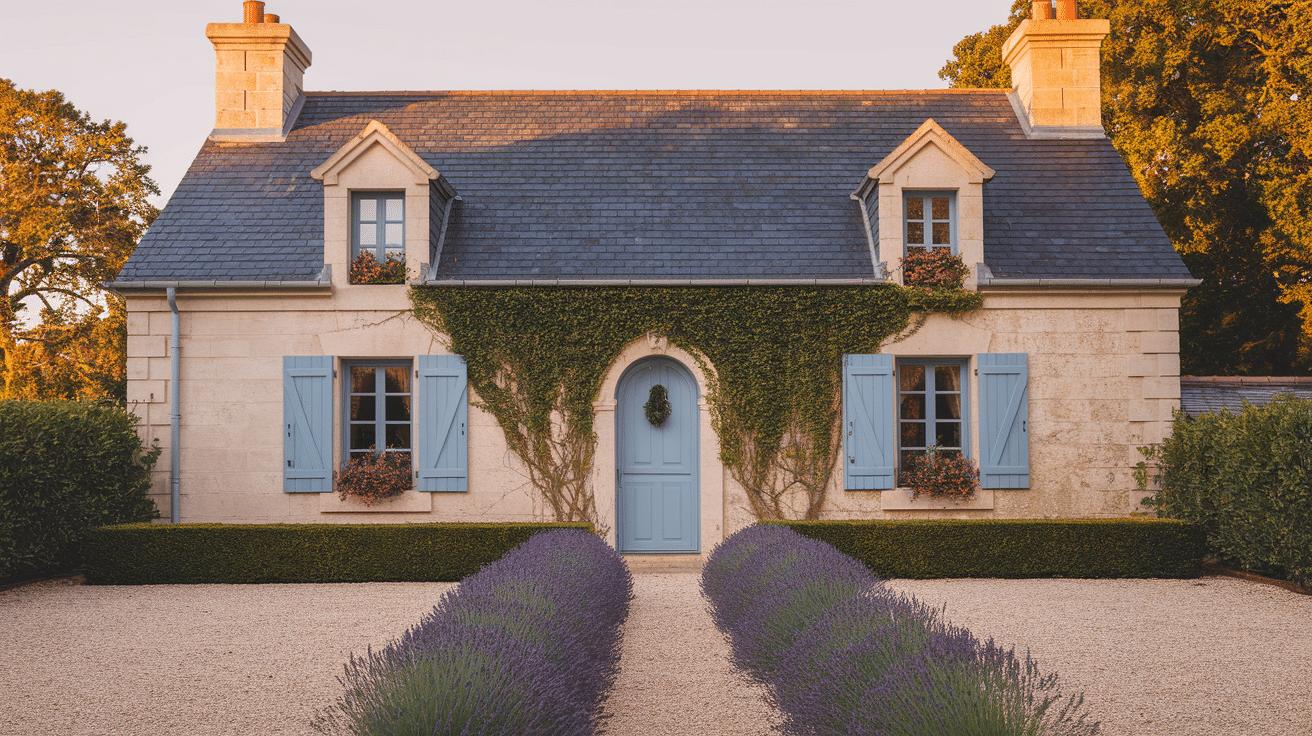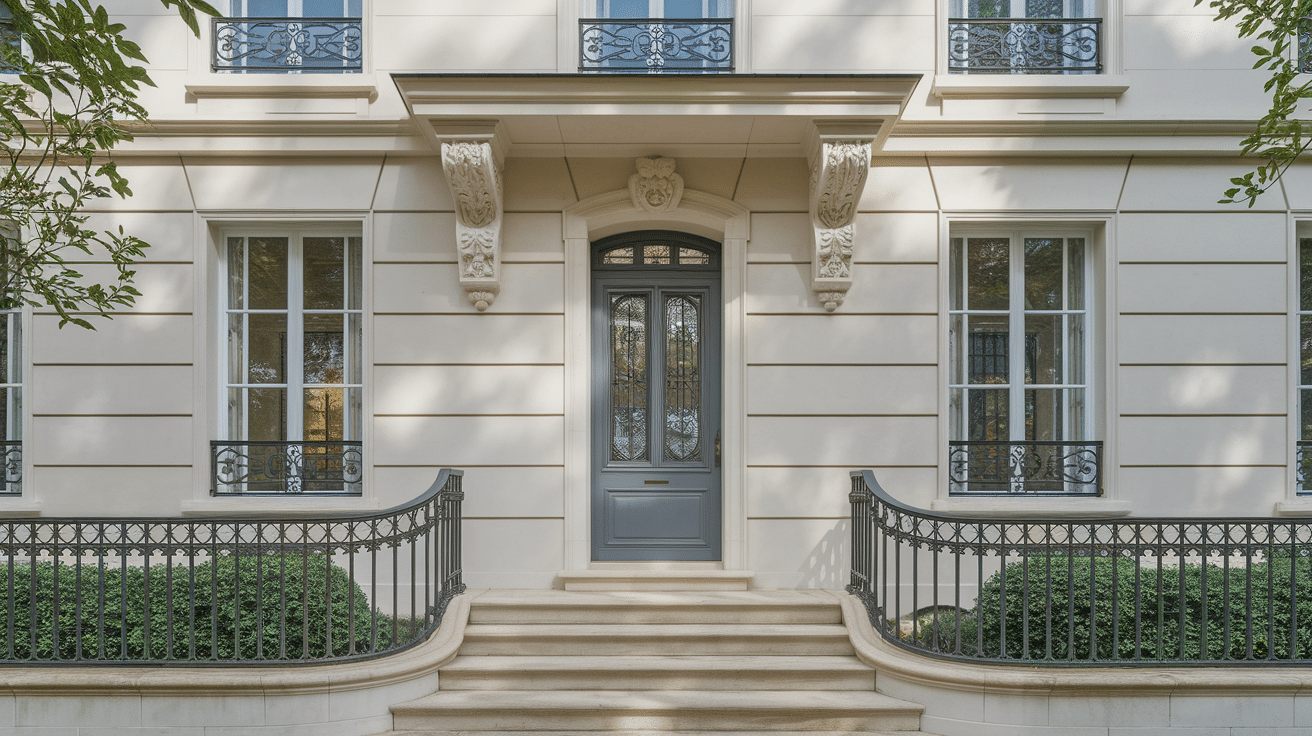There’s something magical about a French country cottage that instantly transports you to the rolling countryside of Provence.
As someone who’s spent years admiring these charming structures, I’ve come to appreciate their subtle details and timeless appeal.
The gentle blend of rustic elements with refined touches creates homes that feel both welcoming and graceful.
Whether you’re planning a renovation or simply dreaming of future possibilities, these quaint dwellings offer inspiration that transcends trends and captures the heart with their original character and lived-in beauty.
Why You Should Consider a French Country Cottage Exterior
The allure of a French country cottage exterior lies in its timeless charm and romantic appeal that never goes out of style. These homes showcase natural materials and soft color palettes that blend seamlessly with the surrounding landscapes.
They’re particularly ideal for small homes seeking big character without overwhelming proportions. French cottages effortlessly balance rustic elements with refined details for a sophisticated yet comfortable appearance.
Perhaps best of all, they offer exceptional curb appeal without requiring grand scale or ostentatious features.
Picture Perfect French Country Exteriors for Smaller Spaces
These delightful design elements capture the essence of French provincial architecture while remaining accessible for homes of modest size. Each feature contributes to that unmistakable charm that makes these cottages so beloved.
1. Limestone Facade with Blue Shutters
The classic combination of pale limestone walls contrasted with bright blue shutters instantly evokes Provençal charm. This pairing creates a crisp, clean look while honoring centuries-old French architectural traditions that balance simplicity with thoughtful detailing.
2. Weathered Wood Doors and Wrought Iron Lanterns
Solid wood doors with a naturally aged patina serve as a warm focal point for any cottage exterior. Paired with handcrafted wrought iron lanterns, these elements add genuine character while providing functional lighting that casts beautiful shadows across textured walls.
3. Aged Stucco Walls in Soft Cream Tones
Gently textured stucco in warm cream hues mimics the sun-baked walls of southern France. This finish develops character over time, with subtle imperfections that tell a story and create depth through how light plays across the surface throughout the day.
4. Steep Slate Roof with Dormer Windows
A steeply pitched slate roof crowned with charming dormer windows defines the classic French cottage silhouette. This architectural feature adds vertical interest while creating useful interior space and allowing natural light to flood upper rooms.
5. Charming Arched Entryways with Ivy Trim
Graceful stone arches framing doorways create an inviting entrance with European flair. When softened by climbing ivy or flowering vines, these structured elements gain organic beauty that changes with the seasons while maintaining architectural integrity.
6. Vintage Brick and Timber Framed Exterior
Exposed timber framing against aged brick creates textural contrast that honors medieval French building techniques. This combination reveals the home’s structural elements as decorative features, showcasing craftsmanship and historical building methods with authentic appeal.
7. Soft Pastel Siding with White Trim Accents
Gentle hues like dove gray, butter yellow or pale sage green paired with crisp white trim create a subtle color palette. This understated approach allows architectural details to shine while reflecting the soft, natural light quality found in the French countryside.
8. Pea Gravel Driveway and Clipped Boxwood Hedges
Low-maintenance pea gravel driveways paired with meticulously shaped boxwood create structure around cottage gardens. This combination establishes formal elements that balance the casual charm of cottage plantings while providing pleasing crunching sounds underfoot.
9. Stone Chimneys and Wooden Flower Boxes
Substantial stone chimneys anchor cottage exteriors with a sense of permanence and comfort. Window boxes crafted from natural wood add charm while providing space for seasonal flowers that bring color and life to the facade.
10. Natural Wood Beams and Covered Porch Details
Exposed wooden beams extending from the interior to exterior spaces create architectural continuity. When used to frame covered porches, these elements establish transitional spaces that blur the line between indoors and out, perfect for morning coffee or evening relaxation.
11. Copper Gutters Paired with Rustic Shutters
Copper drainage systems develop beautiful verdigris patinas over time, adding living color to cottage exteriors. When combined with authentic wooden shutters featuring traditional hardware, these functional elements become distinctive architectural details that improve with age.
12. Terracotta Roof Tiles and Subtle Stonework
Sun-baked clay tiles in warm orange-red hues create distinctive rooflines reminiscent of Mediterranean France. Complemented by subtle stonework around foundations and entrances, this pairing grounds the home with natural materials that connect to the earth.
13. French Blue Front Doors with Carved Detail
A statement door in classic French blue with carved panels serves as a welcoming focal point. This traditional touch offers a perfect balance of color and craftsmanship, creating an entrance that feels both special and authentically rooted in French design.
14. Lavender-Lined Walkway and Cottage Garden
Fragrant lavender borders leading to the entrance evoke the fields of Provence while attracting beneficial pollinators. Surrounded by informal cottage garden plantings, these pathways engage multiple senses and create seasonal interest throughout the year.
15. Cream-Colored Walls with Grey Shingle Roof
Light-toned wall finishes brightened with cream undertones create a luminous backdrop for architectural details. Topped with sophisticated grey shingles, this combination achieves the perfect balance of warmth and refinement for year-round visual appeal.
16. Farmhouse-Inspired Porch with Rocking Chairs
Deep porches featuring simple wooden rocking chairs offer comfortable outdoor living spaces with rural French charm. These welcoming areas extend the home’s livable square footage while providing ideal vantage points for enjoying garden views.
17. Classic Window Grilles and Flowering Vines
Decorative iron grilles protecting windows add security with artistic flair reminiscent of French country estates. Softened by climbing roses or wisteria, these structured elements gain romantic appeal as flowers weave through the metalwork each season.
18. Pale Yellow Exterior and French Casement Windows
Buttery yellow exterior finishes capture and reflect sunlight, creating a perpetually sunny environment. Paired with authentic outward-opening casement windows, this combination creates a cheerful facade with functional elements that maximize airflow and connection to outdoors.
19. Whitewashed Stone and Arched Garden Gates
Limestone or fieldstone walls softened with traditional whitewash techniques create textural interest with historical authenticity. Complemented by curved garden gates, these elements establish courtyard spaces and garden rooms that extend the living area outdoors.
20. Trellised Roses Climbing Cottage Walls
Strategic trellises supporting heritage roses transform exterior walls into living tapestries of color and fragrance. This traditional French garden technique softens architectural lines while connecting the structure to its landscape through seasonal blooms.
21. Rustic Wood Garage Doors and Stone Framing
Garage doors crafted from weathered wood planks disguise modern convenience behind traditional aesthetics. Framed with natural stone, these utilitarian entrances become architectural features that complement rather than detract from cottage charm.
22. Herb Garden in Raised Beds with Gravel Paths
Functional kitchen gardens featuring culinary herbs in raised limestone beds honor the practical traditions of French country living. Connected by fine gravel pathways, these edible landscapes combine beauty and utility while engaging all senses.
23. Carved Stone Entry with Lantern Lighting
Hand-carved stone surrounds framing entryways display old-world craftsmanship with lasting appeal. Illuminated by traditional lantern fixtures, these welcoming portals create dramatic shadows while establishing a sense of history and permanence.
24. A Mix of Stone and Plaster for Textural Depth
Combining multiple materials like rough-hewn stone with hand-troweled plaster creates visual interest through textural contrast. This layering of surfaces captures light differently throughout the day, bringing depth and dimension to even simple cottage designs.
25. Simple Facade with Delicate French Detailing
A restrained exterior approach with carefully chosen ornamental details demonstrates sophistication through understatement. Small touches like carved corbels or delicate ironwork reflect authentic French design principles where quality craftsmanship speaks louder than grandeur.
Common Mistakes to Avoid With French Cottage Exteriors
- Over-modernizing the facade: Replacing character elements with contemporary features destroys authentic charm. Preserve shutters, textured surfaces, and original detailing that give cottages their timeless appeal.
- Using colors too bold or bright: Authentic French cottages showcase subdued, earthy tones that blend with natural surroundings. Choose muted creams, soft blues and gentle sage greens.
- Ignoring natural landscaping: French cottage gardens should feel effortless and romantic. Incorporate wildflowers, climbing roses, and meandering pathways rather than formal, manicured arrangements.
- Choosing materials that feel too polished: Perfect symmetry contradicts cottage authenticity. Embrace materials with subtle imperfections like hand-formed brick and irregular stonework.
- Forgetting architectural authenticity: Research regional French cottage styles to maintain consistency in roof pitch, window proportions, and decorative elements that reflect genuine provincial character.
Alternate Ideas That Capture the Same Charm
- English cottage style: Features thatched roofs, climbing roses, and asymmetrical charm with cozy proportions and native stone construction.
- Scandinavian country homes: Blend rustic wood elements with clean lines, light colors, and natural materials for serene simplicity.
- Tuscan cottages: Showcase terracotta roofs, stone facades, and cypress trees with sun-baked color palettes and Mediterranean sensibility.
- Farmhouse exteriors: Combine functional simplicity with European touches like wrought iron, salvaged materials, and aged patina finishes.
- Vintage coastal cottages: Feature weathered shingles, faded blues, and romantic details that echo French seaside architecture.
Conclusion
Adopting the essence of French cottage charm requires patience, research, and an appreciation for imperfect beauty. Whether you choose traditional provincial styling or draw inspiration from similar aesthetics like English gardens or Tuscan warmth, the key lies in honoring realism over perfection.
Your home’s exterior tells a story—one of heritage, craftsmanship, and connection to the natural world. By avoiding common modernization pitfalls and selecting materials with character, you create not just a house but a sanctuary with timeless appeal.
Remember that true French cottage style isn’t about rigid rules but rather a feeling—one that welcomes, comforts, and ages gracefully alongside its inhabitants. Ultimately, the most captivating cottages are those that reflect both historical reverence and the unique personality of those who call them home.

































